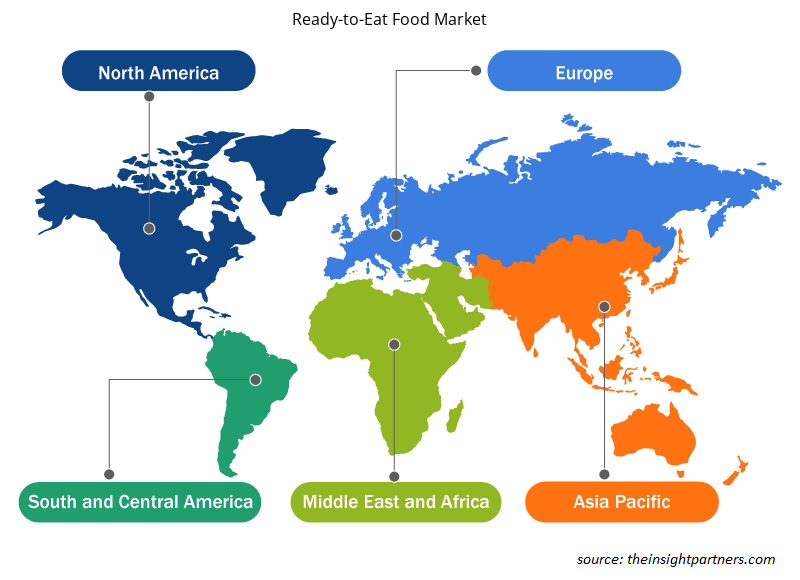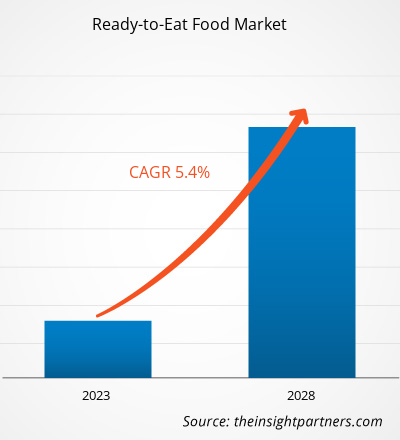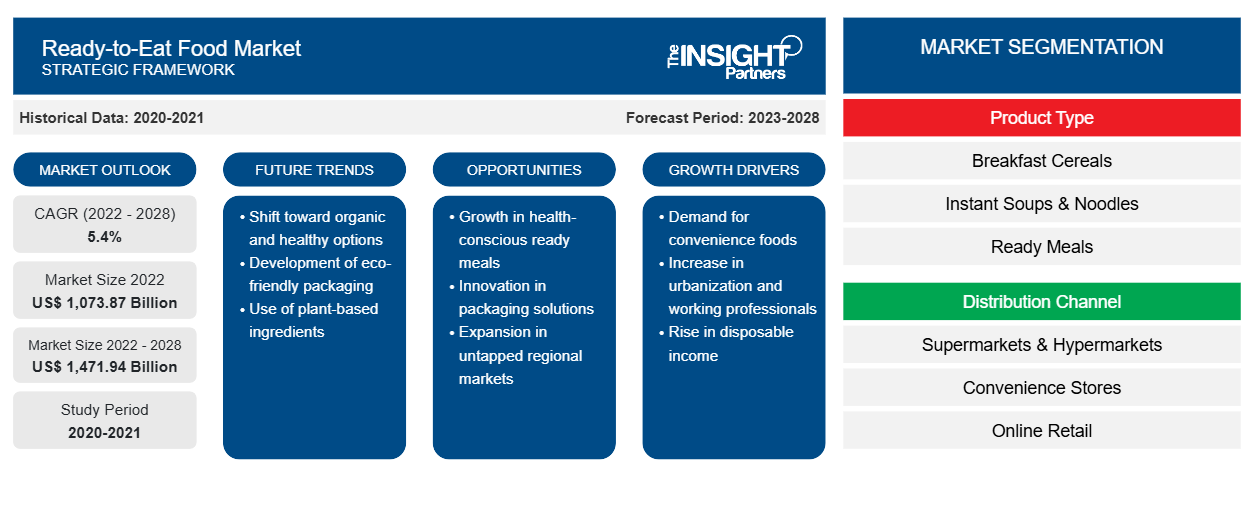[تقرير بحثي] من المتوقع أن يصل سوق الأغذية الجاهزة للأكل إلى 1,471.94 مليار دولار أمريكي بحلول عام 2028 من 1,073.87 مليار دولار أمريكي في عام 2022. ومن المتوقع أن ينمو بمعدل نمو سنوي مركب قدره 5.4٪ من عام 2022 إلى عام 2028.
تتكون الأطعمة الجاهزة للأكل من مجموعة متنوعة من الأطعمة المعالجة والمغلفة التي يمكن تناولها دون مزيد من التحضير. يتم غسل المكونات وطهيها ومعالجتها وتعبئتها في حاويات للاستهلاك المباشر. تشمل بعض الأنواع الشائعة من الأطعمة الجاهزة للأكل الحساء الفوري والسلع المخبوزة والحلويات والوجبات الجاهزة. يتم إثراء هذه المنتجات بمستخلصات مختلفة وأحماض ونكهات ومحليات ومضادات أكسدة ومواد حافظة. إنها توفر راحة هائلة للمستهلك مع المساعدة في تقليل وقت تحضير الوجبة وتوفير عمر تخزين أطول للمنتجات وكفاءة من حيث التكلفة والحد الأدنى من التلف.
استحوذت منطقة آسيا والمحيط الهادئ على أكبر حصة من سوق الأطعمة الجاهزة للأكل في عام 2020، في حين من المتوقع أن تنمو المناطق النامية الأخرى، مثل الشرق الأوسط وأفريقيا، بشكل كبير في الفترة المتوقعة. تعمل الجهات الفاعلة الرئيسية العاملة في سوق الأطعمة الجاهزة للأكل على توسيع عملياتها في جميع أنحاء منطقة آسيا والمحيط الهادئ بسبب ارتفاع عدد السكان العاملين وأنماط الحياة المحمومة للأشخاص في البلدان النامية. يختار الأفراد بشكل متزايد تناول الطعام أثناء التنقل أو خارج المنزل.
علاوة على ذلك، أثبتت العديد من الدراسات أن شركات الأغذية والمشروبات العابرة للحدود الوطنية قد شكلت أنظمة الغذاء والاستهلاك العام بطرق تؤدي إلى تغيير مدى توفر الأطعمة المصنعة ورغبتها وسعرها وفي النهاية استهلاكها. وقد لوحظ نمو سوق الأطعمة الجاهزة للأكل بشكل بارز في البلدان ذات الدخل المتوسط.
قم بتخصيص هذا التقرير ليناسب متطلباتك
ستحصل على تخصيص لأي تقرير - مجانًا - بما في ذلك أجزاء من هذا التقرير، أو تحليل على مستوى الدولة، وحزمة بيانات Excel، بالإضافة إلى الاستفادة من العروض والخصومات الرائعة للشركات الناشئة والجامعات
-
احصل على أهم اتجاهات السوق الرئيسية لهذا التقرير.ستتضمن هذه العينة المجانية تحليلاً للبيانات، بدءًا من اتجاهات السوق وحتى التقديرات والتوقعات.
تأثير جائحة كوفيد-19 على سوق الأغذية الجاهزة للأكل
جلب وباء كوفيد-19 تحديات غير مسبوقة للعديد من القطاعات في أوائل عام 2020. فقد أعاقت عمليات التصنيع عمليات الإغلاق والقيود الحدودية وحظر السفر ووقف التصنيع وغيرها من تدابير السلامة التي اتخذتها الحكومات وفقًا لإرشادات منظمة الصحة العالمية ووزارات الصحة الوطنية. من ناحية أخرى، أثر تفشي كوفيد-19 بشكل إيجابي على سوق الأطعمة الجاهزة للأكل حيث كان المستهلكون وتجار التجزئة يخزنون منتجات الأطعمة الجاهزة ذات الأرفف الأطول. كما شعر المستهلكون الذين يبحثون عن منتجات أغذية ومشروبات معبأة أكثر صحة لتعزيز المناعة بالفزع من تأثير كوفيد-19. بعد ذلك، ركز مصنعو منتجات الأطعمة الجاهزة للأكل على المنتجات الصحية والمغذية الغنية بالبروتينات والقيم الغذائية الأخرى، مما حفز الطلب على المنتجات الغذائية الجاهزة للأكل أثناء الوباء.
رؤى السوق:
التفضيل القوي للأطعمة الجاهزة بين جيل الألفية يدفع نمو السوق
يتزايد استهلاك منتجات الأطعمة الجاهزة ذات الجودة العالية، وهو ما يعد حاليًا أحد أكبر الاتجاهات في صناعة الأغذية. تتيح الأطعمة الجاهزة، مثل منتجات الأطعمة الجاهزة، للمستهلكين توفير الوقت والجهد المرتبطين بإعداد الوجبات والطهي والاستهلاك والأنشطة بعد الوجبة. ويقال إن مصادر تطوير هذا القطاع الغذائي تشمل عدد التغييرات الاجتماعية، وأبرزها العدد المتزايد من الأسر الصغيرة وارتفاع عدد سكان الألفية في جميع أنحاء العالم. وبسبب جداول العمل المحمومة لأبناء جيل الألفية ، فإنهم يفضلون أن يكونوا فعالين في استخدام وقتهم بدلاً من إهداره في المهام المملة. وهم أكثر عرضة لإنفاق أموالهم على الراحة. وبالتالي، فإنهم يفضلون بشكل متزايد منتجات الأطعمة الجاهزة، مثل المنتجات المخبوزة والوجبات الخفيفة ومنتجات الألبان، مما يدفع سوق الأطعمة الجاهزة للأكل إلى الأمام.
رؤى حول نوع المنتج
بناءً على نوع المنتج، يتم تقسيم سوق الأطعمة الجاهزة للأكل إلى حبوب الإفطار والحساء الفوري والمعكرونة والوجبات الجاهزة والوجبات الخفيفة والسلع المخبوزة والحلويات وغيرها. ومن المتوقع أن يسجل قطاع الأطعمة الجاهزة للأكل الآخر أكبر حصة خلال فترة التنبؤ. وتشمل الأنواع الأخرى منتجات الألبان والحلويات والدهون والصلصات والصلصات. وتشمل منتجات الألبان الجاهزة للأكل الآيس كريم والزبادي والحليب المنكه المعبأ والجبن. يستهلك المستهلكون المهتمون بالصحة في الغالب منتجات الألبان لأن منتجات الألبان العادية تعمل على تحسين صحة العظام والأمعاء وتقليل مخاطر الإصابة بأمراض القلب والأوعية الدموية ومرض السكري من النوع 2. نمت شعبية الصلصات والصلصات المصنعة والمعلبة مع تحول الناس عن طرق الحياة التقليدية وتبني أسلوب حياة عصري، مما أدى إلى نمو سوق الأطعمة الجاهزة للأكل.
رؤى إقليمية حول سوق الأغذية الجاهزة للأكل
لقد قام المحللون في Insight Partners بشرح الاتجاهات والعوامل الإقليمية المؤثرة على سوق الأطعمة الجاهزة للأكل طوال فترة التوقعات بشكل شامل. يناقش هذا القسم أيضًا قطاعات سوق الأطعمة الجاهزة للأكل والجغرافيا في جميع أنحاء أمريكا الشمالية وأوروبا ومنطقة آسيا والمحيط الهادئ والشرق الأوسط وأفريقيا وأمريكا الجنوبية والوسطى.

- احصل على البيانات الإقليمية المحددة لسوق الأطعمة الجاهزة للأكل
نطاق تقرير سوق الأغذية الجاهزة للأكل
| سمة التقرير | تفاصيل |
|---|---|
| حجم السوق في عام 2022 | 1,073.87 مليار دولار أمريكي |
| حجم السوق بحلول عام 2028 | 1,471.94 مليار دولار أمريكي |
| معدل النمو السنوي المركب العالمي (2022 - 2028) | 5.4% |
| البيانات التاريخية | 2020-2021 |
| فترة التنبؤ | 2023-2028 |
| القطاعات المغطاة |
حسب نوع المنتج
|
| المناطق والدول المغطاة |
أمريكا الشمالية
|
| قادة السوق وملفات تعريف الشركات الرئيسية |
|
كثافة اللاعبين في سوق الأغذية الجاهزة للأكل: فهم تأثيرها على ديناميكيات الأعمال
يشهد سوق الأطعمة الجاهزة للأكل نموًا سريعًا، مدفوعًا بالطلب المتزايد من جانب المستخدم النهائي بسبب عوامل مثل تفضيلات المستهلكين المتطورة والتقدم التكنولوجي والوعي المتزايد بفوائد المنتج. ومع ارتفاع الطلب، تعمل الشركات على توسيع عروضها والابتكار لتلبية احتياجات المستهلكين والاستفادة من الاتجاهات الناشئة، مما يؤدي إلى زيادة نمو السوق.
تشير كثافة اللاعبين في السوق إلى توزيع الشركات أو المؤسسات العاملة في سوق أو صناعة معينة. وهي تشير إلى عدد المنافسين (اللاعبين في السوق) الموجودين في مساحة سوق معينة نسبة إلى حجمها أو قيمتها السوقية الإجمالية.
الشركات الرئيسية العاملة في سوق الأغذية الجاهزة للأكل هي:
- شركة نستله السعودية
- كوناجرا براندز المحدودة
- شركة كرافت هاينز
- شركة جنرال ميلز المحدودة
- شركة كامبل للحساء
إخلاء المسؤولية : الشركات المذكورة أعلاه ليست مرتبة بأي ترتيب معين.

- احصل على نظرة عامة على أهم اللاعبين الرئيسيين في سوق الأطعمة الجاهزة للأكل
رؤى حول قنوات التوزيع
بناءً على قناة التوزيع، تم تقسيم سوق الأطعمة الجاهزة للأكل إلى محلات السوبر ماركت والهايبر ماركت ومتاجر السلع الغذائية وتجارة التجزئة عبر الإنترنت وغيرها. ومن المتوقع أن يسجل قطاع تجارة التجزئة عبر الإنترنت أعلى معدل نمو سنوي مركب في سوق الأطعمة الجاهزة للأكل خلال فترة التوقعات. توفر تجارة التجزئة عبر الإنترنت تجربة تسوق مريحة للمستخدمين، تليها عملية توصيل مبسطة للمنتجات. تقدم متاجر التجزئة عبر الإنترنت مجموعة واسعة من المنتجات بخصومات كبيرة؛ كما يمكن للمستهلكين شراء المنتجات المرغوبة بسهولة عن بُعد.
الجهات الفاعلة الرئيسية العاملة في سوق الأطعمة الجاهزة للأكل هي Nestlé SA؛ وConagra Brands Inc.؛ وThe Kraft Heinz Company؛ وGeneral Mills Inc.؛ وCAMPBELL SOUP COMPANY؛ وMTR Foods Pvt Ltd.؛ وHormel Foods Corporation؛ وTyson Foods, Inc.؛ وJBS SA؛ وThe Kellogg Company. وتشارك هذه الجهات الفاعلة في تطوير منتجات ذات مخاطر صحية أقل لتلبية اتجاهات المستهلكين الناشئة والالتزام بالأطر التنظيمية. كما تشارك في عمليات الدمج والاستحواذ وتوسيع الأعمال والشراكات لتوسيع حصتها في السوق.
تقرير يسلط الضوء على
- اتجاهات الصناعة التقدمية في سوق الأغذية الجاهزة للأكل لمساعدة اللاعبين على تطوير استراتيجيات فعالة طويلة الأجل
- استراتيجيات نمو الأعمال المعتمدة لضمان النمو في الأسواق المتقدمة والنامية
- التحليل الكمي لسوق الأغذية الجاهزة للأكل من عام 2019 إلى عام 2028
- تقدير الطلب العالمي على الأغذية الجاهزة للأكل
- تحليل القوى الخمس لبورتر لتوضيح فعالية المشترين والموردين العاملين في الصناعة
- التطورات الأخيرة لفهم سيناريو السوق التنافسي
- اتجاهات السوق وتوقعاته والعوامل التي تحكم نمو سوق الأغذية الجاهزة للأكل
- المساعدة في عملية اتخاذ القرار من خلال تسليط الضوء على استراتيجيات السوق التي تدعم المصلحة التجارية، مما يؤدي إلى نمو السوق
- حجم سوق الأغذية الجاهزة للأكل في مختلف العقد
- نظرة عامة تفصيلية وتقسيم السوق وديناميكيات صناعة منتجات RTE
- حجم النمو في مختلف المناطق ذات فرص النمو الواعدة
- التحليل التاريخي (سنتان)، سنة الأساس، التوقعات (7 سنوات) مع معدل النمو السنوي المركب
- تحليل PEST و SWOT
- حجم السوق والقيمة / الحجم - عالمي، إقليمي، بلد
- الصناعة والمنافسة
- مجموعة بيانات إكسل
التقارير الحديثة
تقارير ذات صلة
شهادات العملاء
سبب الشراء
- اتخاذ قرارات مدروسة
- فهم ديناميكيات السوق
- تحليل المنافسة
- رؤى العملاء
- توقعات السوق
- تخفيف المخاطر
- التخطيط الاستراتيجي
- مبررات الاستثمار
- تحديد الأسواق الناشئة
- تحسين استراتيجيات التسويق
- تعزيز الكفاءة التشغيلية
- مواكبة التوجهات التنظيمية























 احصل على عينة مجانية ل - سوق الأطعمة الجاهزة للأكل
احصل على عينة مجانية ل - سوق الأطعمة الجاهزة للأكل